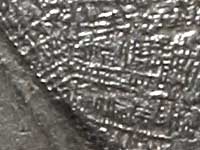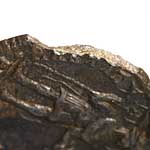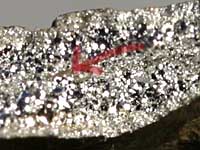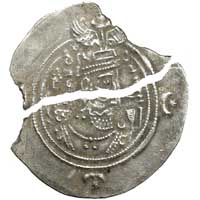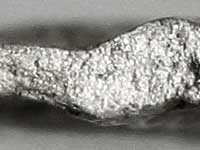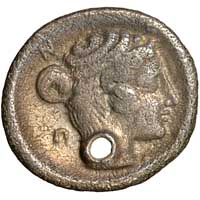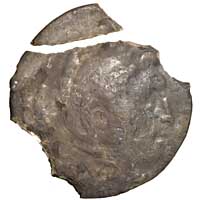| Home Page | Site Map | Useful Links | Email Me | Glossary | Next Page |
| ---------- Interesting Things About Ancient Coins ---------- |
| Crystallisation and Embrittlement of Ancient Coins |
| You can click on any coin image to see the full coin. |
 ncient silver artifacts tend to suffer from a condition which is known as "embrittlement." There are two main types of embrittlement. In one, the silver making up the artifact forms into crystals, with sharp edges and planes that can easily come apart under stress or shock. In the other, the silver gets a blocky surface appearance for which the nicest word I have come across is "cracquelure." The latter is quite different from crystallisation and as far as I have been able to see, it doesn't have the same weakening effect on a coin.
ncient silver artifacts tend to suffer from a condition which is known as "embrittlement." There are two main types of embrittlement. In one, the silver making up the artifact forms into crystals, with sharp edges and planes that can easily come apart under stress or shock. In the other, the silver gets a blocky surface appearance for which the nicest word I have come across is "cracquelure." The latter is quite different from crystallisation and as far as I have been able to see, it doesn't have the same weakening effect on a coin.
This page will also look at lamination effects and a sort of graininess that may be linked to blockiness.
There is another phenomenon in which the centre of a coin takes on what has been described as a whitish clay-like appearance and texture. There is more about these at the very bottom of this page.
There is also a brief look at a normal coin for comparison, and views of a couple of thin coins.
Crystallisation
First, here are some examples of coins showing clear evidence on their surfaces of crystallisation.
This Corinthian stater shows the goddess Athena wearing a Corinthian helmet over a leather cap. The helmet is tilted back, so that its nose guard lies above the peak of the cap. A long flap protects her neck and there is a flower symbol behind the head.
At first glance, this coin looks as though the surface has become unpleasantly pitted. This is not the case. You can see from the enlargement of part of the hat that there is a regular criss-cross pattern underneath the smooth original surface. The regular arrangement is typical of a crystal formation.
The pattern has been exposed on the high points where the original surface has worn away.
The contrast between the smooth surface and the underlying hatchwork is a very clear example of how the surface and interior structures of an ancient coin can differ.
This is the obverse of a denarius of Elagabalus, showing the laureate bust of the emperor. It was struck in Antioch. The style is very distinctive, and quite different from coins struck at the Rome mint.
This coin surprised me. I bought it as a coin of the "limes," the borders of the empire, where it is common to find base metal versions of denarii of around this period. The coin looked brownish, like dirty bronze, in fact quite like other limes coins of the period. But when I photographed it and looked at the detail (this time, the mouth), there again were the typical signs of crystal patterning.
As this only occurs to silver, clearly what I have here is a dirty silver coin. The dirt is worked into the surface and might be held more securely by the tiny crevices around the crystals.
This sort of crystallisation is rare in Roman denarii.
This is the obverse of a much older silver Greek trihemiobol, which shows a satyr kneeling and holding a kantharos in his outstretched hand.This remarkable coin has been so thoroughly crystallised that it has lost considerable detail and definition. The only non-crystalline area is on the reverse, where there has been some sort of damaging contact. This has destroyed and smeared the crystal structure and restored the damaged area to its former, apparently homogeneous, state. The photo on the right shows the edge of this section of the reverse.
An example of how this coin should look is on my Hellenic holed coins page.
Normal Coins
It's going to be useful to know what the interior of a normal, un-embrittled coin looks like.
This is the reverse of a denarius of Hadrian, showing a female with attributes of Roma and Virtus seated on a cuirass and shield, holding a spear and parazonium.
I bought this broken denarius in this condition, being interested both in the reverse type (see my Virtus page) and its interior. On the right you can see a close-up of the broken edge. This appears to be about as toned as the surface, so the break can not have been recent, though it's possible it could still have occurred within a century or so. But the exact date isn't critical to an examination of its structure. At first glance with the naked eye it looked fairly homogeneous, but the close-up begins to reveal some detail.
 Here is the same edge at maximum magnification. Three points can be noticed. Firstly, the surfaces of the coin seem tougher and more coherent than any of the interior. The surface layers, indicated by red arrows, stand out slightly from the rest and are shinier at the broken edge.
Here is the same edge at maximum magnification. Three points can be noticed. Firstly, the surfaces of the coin seem tougher and more coherent than any of the interior. The surface layers, indicated by red arrows, stand out slightly from the rest and are shinier at the broken edge.
Secondly, the interior has a layered structure, with stronger and weaker layers interleaved. I have put translucent red dots along the lines of the stronger layers which, like the surface, are shinier and stand out more. The layers are not exactly parallel to the surfaces. In fact, seen like this in cross-section, they seem to branch out. But they follow the shape of the coin approximately, going more or less along with the surfaces rather than across between them. Every denarius I have seen the inside of has shown some sort of layering, with the surface layers being the most apparent. Internal layering this clear is not so common, so other examples have a sandwich appearance.
And thirdly, it appears to have areas of major weakness, such as the large brownish area on the left of the large close-up, which doesn't show any obvious structure – though this might be because dirt accumulating in this hollow has covered up the signs.
Lamination
This is the reverse of a denarius of Hadrian, showing the emperor sacrificing at a tripod altar.This coin has a very revealing fault. The surface layer has developed so differently from the layer beneath that part of it has flaked away. You might think that this is a fourrée, a contemporary fake with a core of base metal, but a view of the edge shows nothing but pure silver. I even scratched a suspicious part of the edge with a knife, revealing nothing but a silvery gleam.
This is known as a laminar or lamination fault, and they are reasonably common. The flaking might occur during striking or later. Thermal stress, for example fast cooling of a freshly struck coin, might cause this flaking to occur.
This has a very noticeable, even dramatic appearance, but we can see that it is only a more advanced version of a layering effect which is common in denarii.
Below left is a three-quarter view of a broken silver siliqua of Valens. It was broken by the detectorist who found it. He was too hasty in removing it from a clod of frozen mud. This view shows part of the reverse, with the emperor standing holding a miniature Victory. Next to it, an enlargement of the broken edge of the coin.
As you can see, the broken edge is far from smooth, and is full of shiny crystal edges and surfaces. You can also see that even though this is a thin coin, its substance appears to be in layers with distinct boundaries, indicated by arrows in the enlargement, where the centre of the broken edge is expanded.
 The detail in this small inset shows where a gap has opened along a central fault, probably under the same stress that caused the chip to break off. The layers which probably already existed on this coin have parted under stress. So it looks as though becoming crystallised weakens the coin not only along the planes between the crystals, but also along the pre-existing layering.
The detail in this small inset shows where a gap has opened along a central fault, probably under the same stress that caused the chip to break off. The layers which probably already existed on this coin have parted under stress. So it looks as though becoming crystallised weakens the coin not only along the planes between the crystals, but also along the pre-existing layering.
The split in the centre is particularly easy to find in crystallised coins.
Below left is a three-quarter view of a contemporary imitation of a Thasos tetradrachm showing the broken edge. This view shows part of the reverse, with Herakles standing holding his club. On the right, an enlargement of part of the broken edge.
This is another very crystallised coin. Even though it's an imitation, it has been made of very pure silver, showing that the imitation was not an attempt to deceive, but to make a coin that looked like the good currency it was by imitating a trusted issue of Thasos. It has crystallised right to the centre – big, blocky, showy crystals.
This coin, too, shows clear signs of an interior structure. Just under each surface is a layer of small crystals; then a layer of much larger ones with flat shiny sides. At the centre is a discontinuity, and though it's hard to see in the photo, where the red arrow is pointing is a flat surface parallel to the coin's surfaces. This is such a definite fault that in places, the obverse and reverse of the coin have fractured along different lines. Although it's not evident from the cross-section, there must also be a thin surface layer, because the crystalline structure does not show at all on the coin's exterior.
This weak central plane is not apparent in the uncrystallised denarius shown earlier. It is suggestive of the crystallisation having taken place from the outside in, so that impurities which do not form part of the structure of the crystals end up pushed to the centre of the coin. Many years ago I used to make lollipops by freezing a strong hot chocolate drink, and I observed the same phenomenon then. Though, the time taken to form those crystals was hours rather than centuries. Other experience in growing crystals tells me that the larger crystals towards the centre of the coin must have formed much more slowly than the smaller ones towards the outside.
There is no evidence that this coin had a pre-existing layered internal structure like the uncrystallised denarius or the crystallised siliqua.
 o, we can see that some silver coins have a tendency to become crystalline; that this is not necessarily obvious from an examination of the surface of the coin; that such coins are weakened in more than one dimension. We can conclude that it is unwise to subject ancient silver coins to shocks or stress. Some individuals test coins for purity by subjecting them to a "ring test", by dropping or striking them onto a hard surface to hear the tone that is produced. All I can say about that is .. not with MY coins!
o, we can see that some silver coins have a tendency to become crystalline; that this is not necessarily obvious from an examination of the surface of the coin; that such coins are weakened in more than one dimension. We can conclude that it is unwise to subject ancient silver coins to shocks or stress. Some individuals test coins for purity by subjecting them to a "ring test", by dropping or striking them onto a hard surface to hear the tone that is produced. All I can say about that is .. not with MY coins!
Thin Coins
Does the thickness of the coin make a difference? Apparently not. The siliqua shown above is thin, as is the Kyzikos obol below.
And here are the typical criss-cross patterns appearing on the rim of a thin Sasanian drachm. At an untypically thick part of the edge of the coin, you can see the same patterns.
The imitation Thasos tetradrachm and the Corinthian stater, on the other hand, both shown above, are relatively thick coins.
Below is a chipped and broken drachm of Khushrou II.
The coin was already chipped when I bought it, missing those two edge pieces, but I did not realise how brittle and weak it was, and it broke as I handled it. It was as fragile as a thin biscuit.
This should be a warning to anyone handling thin coins which are usually strong!
You can see the same central discontinuity in the interior structure of this coin as was visible in the much thicker Thasos example shown above.
Blockiness
Blockiness or "cracquelure" is a very different phenomenon, but one which might also weaken a coin. It is more often apparent on the surface of a coin because it does not seem to be inhibited by the nature of a surface layer, as crystallisation clearly is. Many dislike its appearance, but I find it to be sometimes very aesthetic. Here are some examples.
This tiny coin is an obol from Kyzikos. Under magnification it shows an artistic design, with a lion's head on one side and the forepart of a boar on the other. This is the boar side, and the detail – the area just to the left of the lower half of the reversed E – shows a pattern which is more blocky and less ridged than the needle-like appearance of the crystals we have seen so far on coin surfaces.
This chunky little coin is a drachm from Apollonia Pontika. This is the obverse, showing an anchor. The pattern on this coin shows clearly on the high points. The detail view is the top left-hand edge of the anchor. The irregularity of the blocky structure shows that this can't be a true crystal formation.
The other side of this coin is on my Story of Medusa page.
This is the reverse of a hemidrachm from Neapolis, showing a young female head.
There is another blocky pattern on this nicely toned coin. The detail is from the lower part of the face. It's interesting that the arrangement of blocks seems to follow the contours of the design. This is just one of many similar observations on different coins suggesting that the shock of striking has had a profound effect on the internal structure of a coin.
On the left is the obverse of a Persian drachm, showing the head of Ardashir II. On the right is a detail from the same coin.
The blockiness on this drachm covers the whole of the reverse, but on the obverse, shown here, the area struck by the die does not seem to be affected, only the area near the rim of the flan. There is a flow pattern inside the blocky area where metal would have moved into the raised dot pattern at the time of striking, and this appears also to show some signs of being emphasised by differential leaching. This suggests that whatever allows the separation into blocky areas was present before the coin was struck, and has been partly destroyed here by the effect of striking.
What might cause this phenomenon? Well, the silver used for coins would always contain a small amount of copper, which is naturally present in the ore and strenghtens the coin. It also contains lead, which is naturally present in the ore - in fact it would be more accurate to say that silver was present in lead ore, and was extracted by removing the lead. Silver at room temperature can contain about 1 per cent of copper without any problems, just as water can hold salt in solution. And like water and salt, hotter silver can dissolve more copper. The same is true for lead. But if more than this small proportion is present, it will tend to separate out.
Separating out is not so easy in solid metal. It would take a long time. Heating the metal might speed the process up – for example, when silver is heated to make coins, struck, and then cooled. The excess lead and other impurities might then begin to separate out. These impurities might then corrode or be leached out at a different rate from the silver, thus leaving this blocky appearance. Copper would certainly corrode faster than silver.
The evidence of the Persis drachm suggests that the separation occurs quite quickly, perhaps while the flan is cooling before it is struck. (Though not everyone agrees with this idea.) The actual leaching and blockiness would not appear for centuries.
This is interesting. If the separation into blocks can occur quickly, perhaps coins can also crystallise quickly. We have seen evidence that the exterior crystals formed more quickly than those deeper in, and the exterior of the coin would have cooled more quickly than the interior. Coins that show crystals on their surfaces, or have near-surface crystals exposed by wear, show crystal structures which are fine and often needle-like. The whole crystal structure of the coin could have been formed in minutes, making the coin relatively fragile, and then been exposed only when the coin is broken. I am not declaring this to be a fact, but it is an interesting conjecture. The evidence against it is the existence of coins like the small Thasos trihemiobol with a completely crystallised surface, which seems much more likely to have formed over a long period of time. But the two possibilities are not exclusive. Evidence in favour of both slow and fast crystal formation might mean that both could occur.
Graininess
Blockiness must surely also weaken the structure of a coin, yet while the phenomenon is common, examples of broken coins with an exposed internal blocky structure are much less common than breaks which expose crystals. Here are two examples.
On the left is the reverse of a broken Republican denarius, showing Clio, the muse of history, reading a scroll and leaning on a column. On the right is detail of the broken area of the same coin.
A section has broken off this denarius, perhaps due to rough treatment in the ground before it was dug up – it has a scratched surface typical of a coin that has been dug from the earth, and another clue is that I bought it from a detectorist. You can see that for part of the break, it has split along a plane of weakness more or less parallel to the faces of the coin - just like the planes shown earlier. From the enlargement, it is clear that the interior of this coin has a very lumpy and uneven consistency.
On the left is the reverse of a silver siliqua, with vows inside a wreath. On the right, detail from a chipped area on the edge of the same coin.
In this enlargement you can see that the interior of the siliqua has a granular appearance. The grains are finer than in the previous coin, but are clearly not crystals.
If you imagine that lumpy layer smoothed into a surface, it might look very like the surface of the blocky coins shown above. This weakness, once again, is along a central plane; I have no evidence of blockiness causing coins to be more susceptible to the chipping type of breakage shown by crystallised coins.
Clayishness
 inally ... the type of weakness mentioned at the start, were the interior of a silver coin becomes white and clay-like.
inally ... the type of weakness mentioned at the start, were the interior of a silver coin becomes white and clay-like.
This interesting coin was donated for this page by Salem Alshdaifat of Holyland Numismatics. It is weak and brittle, and the interior is a fine granular material, slightly yellowish. This is what people describe as a clay-like or even ceramic interior, so much so that they find it hard to believe that it is a genuine silver coin.
But the blow-up on the right actually reveals quite a lot of structure. There are up to six layers of dark material around the outside of the coin. We already know that the exterior of a crystallised coin will be different from the inside. The interior of this coin has a fine granular structure. There are no shiny sides or edges, no large blocks. The layers of the surface do not stop abruptly, and the inner layers have the same grainy look as the deep interior; but there are no clearly defined laminations in the centre part of the coin, not even a discontinuity along the centre. There is a dark inclusion which might perhaps have weakened the coin even further and helped select this as the breaking point.
What is this? We know it began as silver, and there is no obvious reason why it should not still be silver. It does not show on the surface of the coin, unlike blockiness; there are no shiny planes or regular patterns, unlike crystallisation. It seems most likely to be something like the grainy interior you can see in the two coins just above this one, with the grains reduced to a very small size. So it might in fact be the same phenomenon, but with the grains on a smaller scale.
Salem, who donated this coin, thinks this condition is caused by the coin resting in conditions of excessive wetness. It seems reasonable to theorise that some unusual conditions have caused this to happen, but there is no actual evidence either way.
This page, translated into Dutch, appeared in the Belgian magazine "De Muntmeester" in September 2008 under the title "Kristallisatie en brosheid van oude munten."
| The content of this page was last updated on 12 February 2010 |
| Home Page | Site Map | Useful Links | Email Me | Glossary | Next Page |

